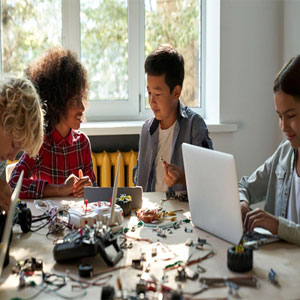Creativity As Experimentation: The Role of Play in Technical Skills-Building
 When people think about technical skills, they often think about disciplines like data analysis, web development, software engineering, database management, bookkeeping, and UX and graphic design. On the surface, these are jobs that require technical skills, such as strong writing and reading, attention to detail, and pattern recognition.
When people think about technical skills, they often think about disciplines like data analysis, web development, software engineering, database management, bookkeeping, and UX and graphic design. On the surface, these are jobs that require technical skills, such as strong writing and reading, attention to detail, and pattern recognition.
Yet, rote performance of tasks, like those found in the day-to-day routines of the roles mentioned before, is just that: rote performance of tasks. Innovation rarely comes from rigid adherence to established rules. Instead, breakthroughs often emerge from experimentation, a skill all its own that is built upon creativity and thrives on curiosity, taking risks, and—very importantly—play.
“Play,” here does not necessarily mean recess, or playing around. In the broadest sense of the word, “play” can be taken to mean trying out new things, having fun with something. A habit for play, or embracing creative experimentation for its own sake, is a key factor in cultivating and building young people’s technical skills by preparing them to ask “what if?” questions, recognise new patterns and connections, and build resilience by learning from trial and error.
Asking “what if?” questions
Students and graduates should be encouraged to experiment often. Experimentation is the true engine of creative learning, encouraging folks to try out new ideas and experiences in an applicable sense without seeking perfection.
They can ask a question, experiment with it, and learn from the results and failure—like in a sandbox environment with low risk, high reward. Students should be encouraged to ask “what if?” questions with no fallbacks no matter where they are in life.
There are many creative outlets available where students can ask “what if?” and explore new ideas freely, such as Adobe Firefly's AI image generator, which allows for inventive play with visual media. In a creative generative AI program like Firefly, students can ask creative questions like “What does a skyscraper look like in a classical, Greco-Roman style?” or “What does the inside of a black hole look like?” It may not be something that could ever work in real life, but who cares? It’s fun to ask, and that’s the point!
By encouraging students to be creative, emphasising experimentation for play’s sake in spite of failure, they will value innovation over results. By seeking innovation and new experiences more and more, experimentation can turn errors and setbacks into essential data points, priming them for technical skills requiring pattern recognition.
Recognising new patterns and connections
One of the most valuable outcomes of prioritising play and asking “what if?” is the ability to recognise patterns and make new connections. Recognising patterns is not simply spotting repetition, but finding and recognising connections—connecting the “what if?” to why.
In technical fields, like in engineering and natural sciences, this can often lead to innovation. Many groundbreaking ideas come from transferring data and knowledge from one domain to another via analytics.
Engineers must know how to take mathematical data and apply it to designs and construction, as do chemists and biologists. While structure and repetition teach rules, it is exploration that helps learners see how those rules interact, overlap, and evolve.
Play cultivates this expansive mindset by lowering the stakes. When failure is treated as exploration, learners become more willing to notice finer details and test even more unusual connections, more “what ifs” and “whys”. Over time, they will develop the confidence to apply these insights to more formal, high-stakes settings without fear of failure.
Resilience in learning from trial and error
Trial and error is not just about persistence. Rather, it is a creative process that transforms failure into feedback, making it a learning tool. While instruction teaches the “right” way to do something, it is through making mistakes often and reflecting on them that students can develop deeper understanding and resilience.
By embracing mistakes as feedback, students deepen their understanding, growing more resilient and unafraid of failure. This helps nurture an environment where experimentation is celebrated, and where challenges are viewed as opportunities. Every “failure” becomes a step towards improvement and mastery. Through this lens, the journey of learning becomes a dynamic exploration, propelled by curiosity and the persistent pursuit of knowledge.
It all comes full-circle, then: trial and error, predicated by asking “what if?” and learning from patterns produced by success and failures, builds up students' curiosity – which leads to bigger “what ifs” and bigger patterns, and so on.
Why Creativity And Play Matter Today
Technology evolves faster than ever. What is cutting-edge today may be outdated tomorrow. Rigid technical skill-building alone cannot keep up. Establishing successful innovation ecosystems that incorporate play in education will prepare students for success.
Learners who embrace play, experimentation, and trial and error will build the adaptability needed to thrive in uncertain industries. They will be creative and inquisitive, recognise patterns across different contexts, and bounce back from setbacks using trial and error as stepping stones.
By embracing creativity as experimentation, students will develop more than just technical skills for a job. They will develop the tools needed to be true innovators wherever they are.

